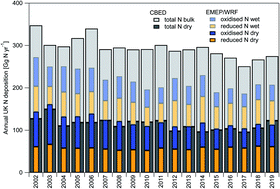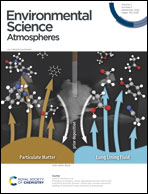Review of methods for assessing deposition of reactive nitrogen pollutants across complex terrain with focus on the UK
Abstract
This review is a summary of the most up-to-date knowledge regarding assessment of atmospheric deposition of reactive nitrogen (Nr) pollutants across complex terrain in the UK. Progress in the understanding of the mechanisms and quantification of Nr deposition in areas of complex topography is slow, as no concerted attempts to measure the components of Nr in complex terrain have been made in the last decade. This is likely due to the inherent complexity of the atmospheric processes and chemical interactions which contribute to deposition in these areas. More than 300 studies have been reviewed, and we have consulted with a panel of international experts which we assembled for that purpose. We report here on key findings and knowledge gaps identified regarding measurement and modelling techniques used to quantify deposition of Nr across complex terrain in the UK, which depending on definition, may represent up to 60% of land coverage across Great Britain. The large body of peer reviewed papers, reports and other items reviewed in this study has highlighted both the strengths and weaknesses in the tools available to scientists, regulators and policy makers. This review highlights that there is no coherent global research effort to constrain the uncertainties in Nr deposition over complex terrain, despite the clearly identified risk of N deposition to ecosystems and water quality. All evidence identified that enhanced Nr deposition across complex terrain occurs, and magnitude of the enhancement is not known; however, there are major uncertainties particularly in the differences between modelled and measured wet deposition in complex terrain and representing accurate surface interactions in models. Using simplified estimates for Nr deposition, based on current understanding of current measurement and model approaches, an enhancement across UK complex terrain in the range of a factor of 1.4–2.5 (i.e. 40–150% larger than current estimates) is likely over complex upland terrain. If at the upper limits of this, then significantly more ecosystems in the UK would be at a direct risk of degradation, and the potential for long-term non-remediable water quality issues increased.

- This article is part of the themed collections: Environmental Science Atmospheres Recent Review Articles and World Earth Day


 Please wait while we load your content...
Please wait while we load your content...